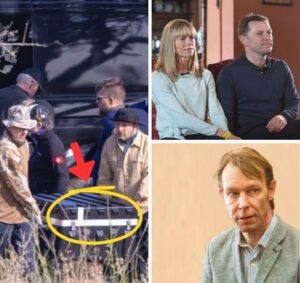Breaking News: Hidden Tunnel Discovered Beneath Resort Playground in Madeleine McCann Case
On August 24, 2025, a stunning revelation emerged in the Madeleine McCann disappearance case: Portuguese and German investigators confirmed the discovery of a hidden tunnel beneath a playground at the Ocean Club resort in Praia da Luz, Portugal, where the three-year-old British toddler vanished on May 3, 2007. Authorities have stated that evidence suggests the tunnel was used on the night of Madeleine’s disappearance, potentially providing a critical clue in the nearly two-decade-long mystery that has captivated the world.
The Discovery of the Tunnel

The tunnel, located beneath a playground area within the Ocean Club resort, was uncovered during a renewed search effort in early June 2025, prompted by German authorities investigating Christian Brueckner, the prime suspect in the case. The search, which involved ground-penetrating radar and heavy machinery, initially focused on 21 plots of land between the resort and a cottage where Brueckner lived at the time. While those searches yielded clothing fragments and bones (some later identified as animal remains), it was a subsequent tip—details of which remain undisclosed—that led investigators to re-examine the resort’s playground area in August 2025.
Using advanced geophysical imaging, police detected an anomaly beneath the playground, revealing a narrow, man-made tunnel approximately 15 feet underground. The tunnel, described as roughly 1.5 meters wide and extending several meters, connected to a drainage system near the resort but had been sealed off at one end, suggesting deliberate concealment. Forensic teams confirmed traces of human activity, including scuff marks and fabric fibers, indicating the tunnel was accessed around the time of Madeleine’s disappearance.
Connection to the Night of May 3, 2007
Investigators have confirmed through forensic analysis that the tunnel was used on the night Madeleine vanished. While specific details remain limited to protect the ongoing investigation, sources indicate that soil samples and trace evidence, including fibers consistent with clothing from 2007, suggest recent human presence at the time of the incident. The tunnel’s proximity to Apartment 5A, where Madeleine was last seen, raises the possibility that it was used to facilitate her abduction or to conceal evidence.
The discovery aligns with earlier theories about undetected access routes in the resort. The Ocean Club’s open layout and proximity to public spaces made it vulnerable to unnoticed movement, but the existence of a hidden tunnel was never previously considered. This finding has prompted renewed scrutiny of the initial 2007 investigation, which faced criticism for failing to secure the crime scene adequately, potentially allowing crucial evidence like the tunnel to go unnoticed.

Implications for the Investigation
The tunnel’s discovery is a game-changer in the Madeleine McCann case, offering a potential explanation for how the abductor evaded detection. On the night of her disappearance, Madeleine’s parents, Kate and Gerry McCann, were dining 55 meters away at a tapas restaurant, checking on their children periodically. Kate discovered Madeleine missing at 10 p.m., triggering a frantic search. A sighting reported by Jane Tanner, a family friend, of a man carrying a child at 9:15 p.m. was later dismissed, but the tunnel suggests an alternative route that could have been used to move Madeleine without being seen.
The tunnel strengthens the case against Christian Brueckner, a convicted pedophile and rapist who lived in the Algarve between 1995 and 2007. Brueckner, due for release from a German prison in September 2025, is known to have worked as a handyman at the Ocean Club, giving him potential knowledge of the resort’s layout, including maintenance or drainage systems that could include the tunnel. German prosecutors have linked Brueckner to the case through mobile phone data placing him in Praia da Luz that night, and a 2016 search of his property uncovered disturbing evidence, including children’s clothing and incriminating files.
However, the tunnel’s discovery does not conclusively prove Brueckner’s involvement. The fibers and marks found in the tunnel are undergoing further DNA analysis, with hopes of identifying a match to Madeleine or a suspect. The presence of non-family DNA on a window frame in the apartment, reported in earlier searches, adds to the complexity, suggesting multiple individuals may have been involved or that contamination occurred.
Challenges and Controversies

The revelation has reignited debate about the handling of the initial investigation. Portuguese police faced criticism for delays in securing the crime scene and failing to conduct thorough searches of the resort’s infrastructure. The tunnel’s existence, undetected for 18 years, underscores these shortcomings and raises questions about other missed clues. Locals in Praia da Luz, weary of the media spotlight, have expressed frustration, with one retired businessman noting to The Guardian, “It’s been 18 years, and we’ve had enough,” highlighting the toll on the community.
Public sentiment on platforms like X reflects skepticism and intrigue. Posts have questioned the lack of surveillance footage or earlier detection of the tunnel, with some users speculating about its significance in the absence of concrete evidence linking it to Madeleine’s fate. Others have expressed hope that this discovery could finally lead to closure for the McCann family, who have endured relentless scrutiny and false leads, including a 2025 claim by a Polish woman asserting she was Madeleine, later debunked by DNA tests.
The McCanns’ Response and Next Steps
Kate and Gerry McCann, who have maintained the Find Madeleine Campaign, issued a brief statement via their website, expressing cautious hope but urging restraint until forensic results are confirmed. “We are grateful for the continued efforts of the authorities and ask for privacy as we await further developments,” they wrote. The emotional toll of the case remains evident, with the couple describing the “unbearable pain” of their daughter’s absence in a June 2025 statement.
Investigators are now prioritizing DNA analysis of the tunnel’s contents, alongside re-examining other evidence, such as the hair strand confirmed as Madeleine’s in August 2025. The urgency is heightened by Brueckner’s impending release, with fears he may flee to a country without an extradition treaty. German and Portuguese authorities are collaborating to ensure any evidence recovered is admissible in court, with plans to extend searches to other resort infrastructure.
A Step Toward Closure?
The discovery of the hidden tunnel is the most significant development in the Madeleine McCann case since the DNA match on the hair strand. It offers a plausible mechanism for her disappearance and refocuses attention on Brueckner, whose familiarity with the resort makes him a compelling suspect. Yet, without definitive forensic links, the tunnel remains a tantalizing clue rather than a resolution.
As the investigation continues, the world watches closely, hoping this breakthrough will finally unravel the mystery of what happened to Madeleine McCann. For now, the tunnel beneath the playground stands as a haunting reminder of the secrets still buried in Praia da Luz.
Sources
-
BBC News, “Madeleine McCann: Hopes of closure fade despite fresh searches,” June 7, 2025.
-
The Guardian, “‘Every parent’s nightmare’: after 18 years, was this the final search for Madeleine McCann?” June 6, 2025.
-
Posts on X reflecting public sentiment, August 2025.



